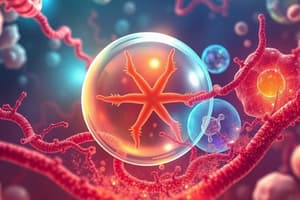Podcast
Questions and Answers
The movement of molecules from high to low concentration without energy input is called ______________ transport.
The movement of molecules from high to low concentration without energy input is called ______________ transport.
passive
The process of generating ATP using a proton gradient is called _______________.
The process of generating ATP using a proton gradient is called _______________.
chemiosmosis
The breakdown of organic molecules to generate energy is known as _______________.
The breakdown of organic molecules to generate energy is known as _______________.
catabolism
The specific binding site for a substrate on an enzyme is called the ______________ site.
The specific binding site for a substrate on an enzyme is called the ______________ site.
The regulation of enzyme activity through the binding of effector molecules to a non-active site is called ______________ regulation.
The regulation of enzyme activity through the binding of effector molecules to a non-active site is called ______________ regulation.
The substrate concentration at half-maximal velocity is represented by the symbol ______________.
The substrate concentration at half-maximal velocity is represented by the symbol ______________.
Flashcards are hidden until you start studying
Study Notes
Cell Membrane Transport
- Types of Transport:
- Passive Transport: movement of molecules from high to low concentration without energy input (diffusion, osmosis)
- Active Transport: movement of molecules against concentration gradient using energy (carrier proteins, pumps)
- Transport Mechanisms:
- Simple Diffusion: molecules move through phospholipid bilayer
- Facilitated Diffusion: molecules move through transport proteins (carrier proteins, channels)
- Active Transport: energy-dependent transport using ATP or proton motive force
- Proton Motive Force:
- Electrogenic transport: generates proton gradient across membrane
- Chemiosmosis: ATP synthesis using proton gradient
Metabolic Pathways
- Catabolism:
- Breakdown of organic molecules to generate energy (ATP, NADH, FADH2)
- Examples: glycolysis, citric acid cycle, fatty acid oxidation
- Anabolism:
- Synthesis of organic molecules using energy (ATP, NADH, FADH2)
- Examples: gluconeogenesis, fatty acid synthesis, amino acid synthesis
- Energy Yield:
- ATP generated per glucose molecule: 36-38 ATP (aerobic respiration), 2 ATP (anaerobic respiration)
Enzyme
- Enzyme Structure:
- Active site: specific binding site for substrate
- Apoenzyme: protein component
- Cofactor: non-protein component (coenzyme, metal ion)
- Enzyme Kinetics:
- Substrate binding: formation of enzyme-substrate complex
- Enzyme-substrate complex: transition state, product formation
- Km (Michaelis constant): substrate concentration at half-maximal velocity
- Regulation of Enzyme Activity:
- Allosteric regulation: binding of effector molecules to non-active site
- Feedback inhibition: product inhibits enzyme activity
- Post-translational modification: phosphorylation, ubiquitination
Studying That Suits You
Use AI to generate personalized quizzes and flashcards to suit your learning preferences.



